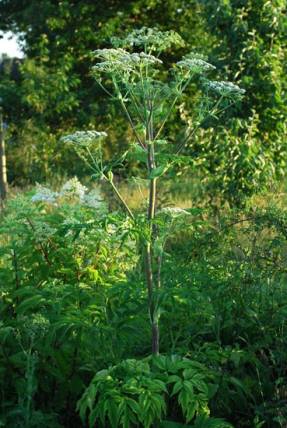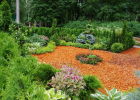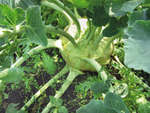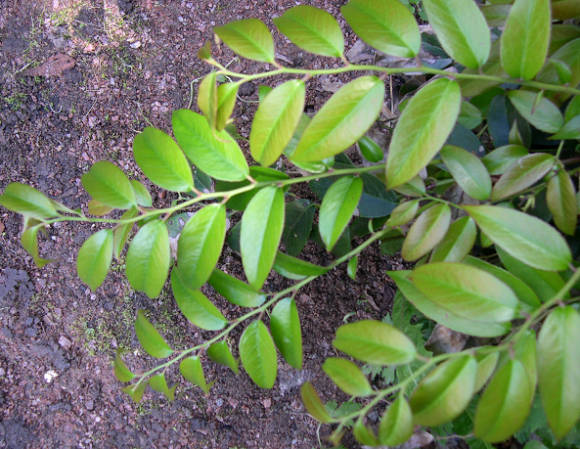For more than one century, lentils have been present on the table of many peoples of the world, suffice it to say that the pharaohs still ate it, and lentil bread was placed in tombs, believing that it would help to overcome the long path to the kingdom of the dead; she is mentioned more than once in the legends of the Old Testament, it was for lentil stew that Esau exchanged his birthright; Roman legionnaires also preferred lentil dishes in their campaigns.
Lentils easily conquered the whole world, in different forms and in different dishes, it is present in many national dishes of the peoples of the world. And in every country - India or Turkey, Iran or Italy, Germany or Romania - they treat it with great love!
There are several types of lentils that differ in their color: red, yellow, green, brown, black. The first two types are easier to boil and are more tender in taste, the rest - retain their shape during cooking and are very good as a side dish. One of the advantages of any lentil is that it does not need to be pre-soaked (except brown!), You just need to sort it out, rinse it, and you can cook it right away.
In our country, the fate of this culture was not easy. In Russia, lentils were so popular that they called them the queen-lentils. Today it is hard to believe that in the 19th century, lentils were one of the main crops exported in our country, and they also had a place of honor in the Russian feast. And not by accident!
In the early nineties of the nineteenth century, when a severe drought occurred in Russia, as a result of which the harvest of almost all cereals was lost, the country was threatened with a terrible famine. Only lentils were born in those years, their harvest was unusually rich, as if she knew that she was called to become the savior of a huge country from starvation: literally everything was prepared from lentils at that terrible time - from stew and bread, to sausages and sweets. Because of its unpretentiousness, it could be found everywhere, and it enjoyed the love of the Russian people more than peas or beans, because in its composition it is in no way inferior to them, but it cooks much faster! And they called her in Russia with deep respect - "the nurse-savior" and "the queen of the table"!
And in the Soviet Union, before the start of the Second World War, lentils occupied huge sown areas - up to 1 million hectares. But in modern Russia it is allotted only a little more than 30 thousand hectares. The irregularities of ripening “ruined” the lentils: half of the pods ripen on the same stem, and it's time to harvest them, and the rest of the pods are still green. Because of this, it is possible to collect lentils only by hand, and therefore, countries with cheap labor, for example, India, have become the absolute leaders in exporting this crop to the world market in the age of mechanization and automation of agriculture.
The beneficial properties of this amazing culture are very significant. Lentils are rich in plant-based proteins, including the essential amino acids isoleucine and lysine, which must be included in a balanced diet. It contains fats, natural sugars, dietary fiber, folic acid, beta-carotene, vitamins A, E, PP, group B; and various minerals: potassium, phosphorus, sulfur, calcium, magnesium, chlorine, sodium, iron, zinc, manganese, fluorine, chromium, iodine (iron contains almost 2 times more than other legumes). Two more essential amino acids - methionine and cysteine - are found only in germinated lentils.
 |
The taste of lentils is very pleasant and delicate and, which is very important, it does not accumulate radionuclides, nitrates and toxins in itself, even if it grows in unfavorable conditions. In addition, unlike many other food products, when cooked, it almost does not lose its beneficial properties.
The healing properties of this culture have also been known to mankind since antiquity.Lentil dishes are very useful for nervous disorders, diseases of the cardiovascular system, diabetes mellitus, ulcers and colitis, they are excellent as a prophylactic agent for oncological diseases and perfectly strengthen the immune system. Thanks to the harmonious set of nutrients, lentils are very useful for pregnant women.
Green lentils
The most common lentils are large and small. Lentil Laird Lentils Laird (laird lentils) - large green lentils - up to 7-9 mm in diameter. It retains its shape perfectly after cooking and has a rich taste and soft texture. This makes it great for salads, vegetable stews, soups and side dishes. French green lentils (or Puy lentils) French green lentils (green french lentils) were developed in a French place called Puy (Le Puy region). It has a bright taste and spicy aroma, practically does not boil over and remains elastic, as if it was originally intended for the most sophisticated salads and unusual side dishes. Today it is called “the pearl of France” and it is grown commercially in the province of Auvergne, where the cool early temperatures and warm late season create ideal conditions for this lentil. Having a more noticeable, as if slightly peppery, aroma than all her other relatives, and an unforgettable outfit - a little bluish with a marble pattern - she rightfully claims to be the best in her family. It also has a very soft skin. It can be used to prepare various salads, a wonderful side dish for chicken, meat or fish, or use in soups and casseroles. In addition to France, today this lentil is also grown in Italy and North America. Hgreen Eston blackberry (Eston lentils) This type of lentil is about 4-5 mm in size and has a pleasant mushroom flavor. Traditionally popular in India, Pakistan and Burma, today it is in high demand everywhere. Used for cooking side dishes, stews, soups, cereals, mashed potatoes, jelly, pates, salads. The cooking time is 20-25 minutes. The intensity of the green color of this type of lentil depends on how long it has been on. Initially green, after drying, the color turns brown over time. When the lentils are cooked, they also turn brown. Green lentils are widespread in the world. In each country of cultivation, it has slight differences in its size and color. Red lentils or Egyptian lentils Red lentils (red split lentils) are eaten almost all over the world, in many countries they are considered a symbol of wealth and good luck, so they must be served at the festive table. Since it is very easy, in just 10-15 minutes, it is boiled in mashed potatoes, it is used to prepare mashed potatoes, cereals, thick stews and pates. The taste of red lentils is perfectly set off by onions, garlic, ginger, thyme, marjoram, mint, bay leaf and black pepper. Red lentils are especially popular in India, where they themselves and dishes made from it are called "masur-dal". Rich in plant protein, vitamins and minerals, it is well-respected by vegetarians, of which there are quite a few in India. In Indian cuisine, it is often mixed with rice and numerous spices (curry, saffron, etc.) Lentils Red Football Red lentils Football (red football lentils) looks very much like a small orange ball, which is why it got its unusual name. This type of lentil is versatile, perfectly suitable for any ingredient: vegetables, meat, fish, and even in combination with rice, it is very original. If you do not cook this lentil a little, it will remain the same perfectly round and will decorate any dish; and if you cook it a little longer, you will get a unique porridge or the most delicate soup-puree from it. After boiling, Football lentils turn from orange to golden yellow, which gives dishes with them a magical golden hue. Turkey is the main producer of this type of lentil, where in family businesses the secret of its processing is passed down from generation to generation within the family business. The production process of Football lentils is rather complicated, as the grains are easily shattered during grinding. The use of oil or water in the grinding process allows you to adjust the brightness and shine of the finished lentil. It is also produced in Syria and Canada. Yellow split lentils are green lentils familiar to us, but pre-polished, as a result of which they are devoid of a shell, and due to the absence of a shell, one of the easiest to prepare. It boils well, so it is great for making pureed soups, pâtés, cereals, stews. It has a pleasant aroma, delicate texture and taste, slightly reminiscent of mushroom, and it takes only 10-15 minutes to cook. Yellow lentils are very popular in India, and also common in Europe, North America, Asia. These are mature, aged seeds of green lentils. Brown lentils boil well and are suitable for making pureed soups and casseroles. The taste of brown lentils is delicate, with nutty or mushroom hints. Pardina lentils or Spanish Brown lentils Light brown, with greenish-black speckled stripes, yellow inside, this type of lentil is very fond of the Spaniards. The size is 4-5 mm. It is cooked quite quickly, in 20-30 minutes, it retains its shape well after cooking. Her taste is special, slightly nutty with an unusual edge. It is great as a side dish without adding any spices or meats, but it also makes great soups, salads and appetizers. Beluga (beluga lentils) is the smallest variety of lentils that gets its name from the round, black and shiny grains that resemble black eggs. This type of lentil is truly royal and differs from all the others in its original appearance, taste and aroma. After cooking, it perfectly retains its shape and its unusual color, has a special unique rich spicy taste and such an aroma, as if a bouquet of spices has already been added to it. Beluga lentils are good as an independent dish and are great for preparing various salads, stews, soups and side dishes. Interestingly, this lentil was originally developed in Canada as a back-up crop. When its taste was discovered and appreciated, Beluga lentils began to be grown for food purposes, despite the fact that this plant is rather short, which makes the harvesting of lentils very difficult, and the product is quite expensive. Although it has a rather delicate skin, it retains its shape perfectly after boiling. During the cooking process, the water and the rest of the ingredients are slightly discolored due to its unusual dark color. It is brewed for only 20-25 minutes. Pre-soaking is not required. Beluga lentils are grown mainly in the USA and Canada. According to research by American scientists, the black pigment of Beluga lentils has powerful antioxidant properties and helps prevent heart disease, cancer, and also slows down the aging process. Cooking lentils will not cause any difficulties even for a novice cook. It is enough just to sort out the grains. It is necessary to sort through any lentils, since manual collection does not completely eliminate the ingress of small pebbles into it. Also, any lentils should be rinsed well in cold water. Proper preparation requires the correct proportions of water and seeds. Lentils absorb water well, and the amount of water depends on the type of dish you want to cook.If lentils for your dish need dense and crumbly, then you need to take 2 times more water by volume than seeds. If you need to get boiled lentils or mashed potatoes, then you can take 3 parts of water. Green-brown varieties of water require slightly more water than red ones. The washed lentils are placed in boiling water, quickly brought to a boil and left to simmer over low heat. Lentils tend to bubble very much - you need to remove the foam and do not cover the pan with a lid until the foam has completely disappeared. Lentils are ideal with fried onions, any fried or stewed vegetables, especially carrots. She makes a wonderful ensemble with most of the seasonings, and the most traditional for the preparation of lentil dishes are the famous Indian spice mixtures - curry and garam masala. It can be cooked not only in water, but also in various broths. Finished lentils are very good when paired with mint, mashed with olive oil. Take the time to prepare such a dressing - the result is worth it! Suitable dressing options for her would be pesto sauce (basil, nuts, olive oil), lightly fried onions and olive oil. Salting lentils is best at the end of cooking, as lentils boil better in unsalted water. All lentils, like other legumes, should be stored in tightly sealed cereal containers in a cool, dry place. You cannot mix fresher grains with old ones, since they have different cooking times. There are a great many recipes for dishes with lentils, we suggest preparing several lentil delicacies from our culinary piggy bank:
Red lentils
Lentils yellow
Brown lentils
Lentils Beluga

Lentil Cooking Secrets








